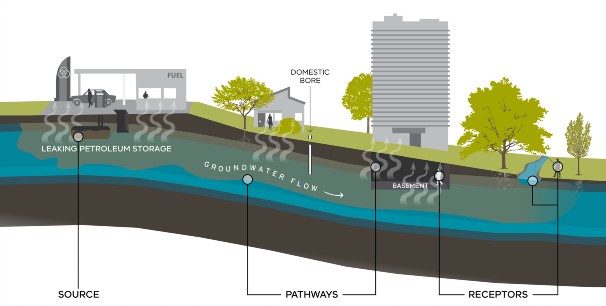Identifying contamination is important because it can cause harm to human health and the environment.
Contamination can become more challenging to address if left unmanaged. It’s especially a problem where the use of the land changes from industrial to a ‘sensitive use’. For example, a home or a childcare centre. If contaminated land will have a sensitive use, you must make it safe for use under the Victorian Planning System.
Exposure to some types of contamination may cause immediate harm to human health. For example, some gases emitted by contaminated land create an explosion risk. Long term exposure to most contamination can cause adverse health risks to the community. For example, some types of contamination can increase your risk of cancer if you’re exposed for a long time.
Some contamination can also move:
- through soil and groundwater
- into the environment and food chain.
Some contamination can travel a long distance from its original site and enter waterways.
Some levels of contamination in soil, groundwater or surface water create an unacceptable risk of harm to human health or the environment. This may mean:
- land becomes unsafe for people to use
- harm to the environment, for example if water sources are contaminated.
For all these reasons, it's important that we take steps to find out if contamination is present and identify actions to help reduce risks of harm to human health and the environment.
You may have a duty to manage contamination on land you manage or control. This includes when you know, or should reasonably know, contamination is present. You can read more about EPA’s expectations in the Contaminated land policy (publication 1915).
Under the duty to manage, EPA expects you to address unacceptable risks of harm from contamination. If risks arise because you’re engaged in an activity that exposes contamination, you must also manage risks under your general environmental duty.
If you manage or control land and fail to address risks, EPA has the power to issue notices. Under these notices you must take action to manage risks.
Understanding how contamination can cause harm
Some substances can cause harm to human health and the environment, including:
- solvents
- oils
- older pesticides
- heavy metals
- industrial wastes.
People often can't see land contamination. Understanding how contamination causes harm can help you manage risks.
For contamination to cause harm, there needs to be:
- A ‘source’ of contamination. This is where the contamination comes from. For example, a leaking oil drum or a landfill site. The original source may no longer be present, but the contaminant could still be.
- A ‘pathway’ through which it could spread. This means how people or the environment come into contact with the contamination. For example, chemicals leaking into groundwater, gas emissions through soil or air or both, or exposed contaminated soil.
- A ‘receptor’ the contamination could impact. Receptors include children, workers, community members, residents and the environment, such as animals, plants and waterways.
Examples of how contamination can cause harm

Source
- A disused underground petroleum tank is leaking hydrocarbons into soil. Hydrocarbons are chemicals found in petrol and many fuels.
Pathway
- Hydrocarbons contaminate the soil and can move into groundwater.
- Migration of contaminated groundwater to other areas, far from the source.
- Local gardens are watered with contaminated groundwater.
- Vapour emissions may enter nearby buildings.
Receptors
- Residents or others in nearby buildings could breathe in the vapours from chemicals in the land or groundwater.
- Construction workers on and off the site may be affected by the contamination.
- Nearby surface water bodies may be contaminated. For example, dams, creeks, rivers, lakes, pools, ponds, puddles and water in stormwater drains.
Harmful impacts
- Risk of harm to the health of onsite workers from breathing in vapours in the air.
- Risk of harm from contaminated bore water through direct skin contact, drinking the water or watering your garden.
- Risk of explosion.
Read next
Reviewed 12 December 2022



